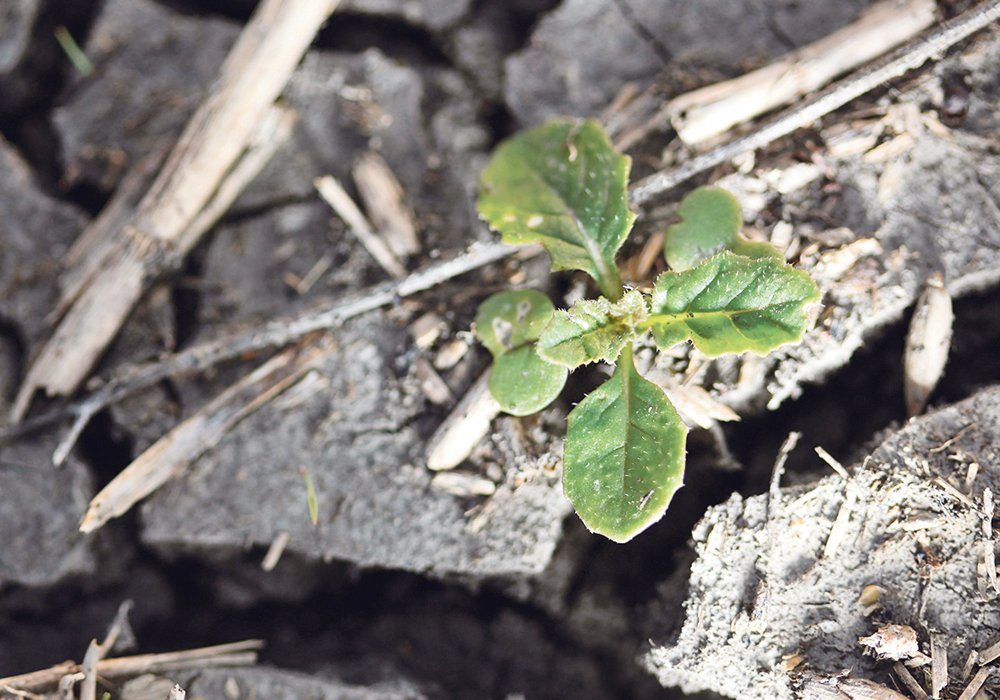Manitoba escapes severe frost damage

The killing frost that hit much of southern Manitoba last week may have caused less damage than expected.
With dry soil conditions in much of the province, canola plants were slow to emerge this spring. So, when temperatures dipped to –2 C to –4 C for several hours on the morning of May 27, a large portion of Manitoba’s canola crop may still have been in the ground.
“All last week and leading up to the frost, I had growers calling and (saying) ‘hey, this isn’t coming out of the ground. It’s been in the ground for over two weeks now’,” said Justine Cornelsen, Canola Council of Canada agronomist for western Manitoba.
This May, canola plants took longer than usual to germinate and pop out of the soil because of extremely dry topsoil in much of Manitoba. And many growers seeded canola deeper than usual, trying to find moisture.
The dry soils, deeper seeding and the delay in crop development likely protected many canola fields from extreme frost damage.
“We’ve had a very dry spring, so canola was often seeded into dry dust. Or not seeded at all… as farmers were holding off, waiting for better growing conditions,” said Dane Froese, Manitoba Agriculture oilseed specialist. “In some cases, farmers were well-advised to have done that (delay seeding).”
For the canola plants that were out of the ground, temperatures were cool over the May long weekend and that may have “hardened” the plants prior to the frost. The freezing temperatures of May 27-28 did injure the plants, but they’re still growing.
Cornelsen has scouted canola fields near Virden, Man., where the plants look horrible. However, the growing point is green and they are bouncing back.
While many canola fields survived the frost, some growers’ crops weren’t so lucky. In places like Arborg, in Manitoba’s Interlake, the frost lasted for 10 hours and temps dropped to –6.4 C.
The frost was also severe in the Parkland region. In Grandview, west of Dauphin, it was below zero for eight hours and temperatures reached –4.7 C.
Producers in those regions may have already re-seeded their canola or will do it soon.
Nicole Clousen, Manitoba Agriculture crop production adviser in Swan River, said it’s hard to know how many acres will be re-seeded. Canola growers in the region assessed their fields over the last weekend in May and are expected to make a decision on whether to reseed during the first week of June.
Thousands of canola acres will be reseeded in Manitoba, but it’s unlikely that 2021 will be a repeat of 2015.
On May 30 that year, temperatures sank to -4 C to -7 C for four or five hours. Elmer Kaskiw, a Manitoba Agriculture crop production adviser at the time, described it as a black frost. Typically, dew forms when temperatures creep toward zero. But there was little or no moisture around at the time.
“We’ve never had this type of black frost,” Kaskiw said. “(The next) morning by nine or 10 o’clock, the plants were turning black…. It really smoked the canola quite badly.”
The dry frost hit much of southern Manitoba and farmers had to reseed nearly a million acres of canola that year.
As for Manitoba’s soybeans, another crop sensitive to frost, 30 or 40 percent may have emerged before the May 27 freeze. That’s a substantial number of acres, with Manitoba farmers expected to seed between one and 1.3 million acres of soybeans in 2021.
But most soybean plants withstood the frost because most had not yet emerged.
“For the most part, we’re OK,” said Dennis Lange, soybean and pulse crop specialist with Manitoba Agriculture. “(But) there’s going to be reseeding in certain pockets… because that’s how frost moves across, into low lying areas.”
Source: producer.com

